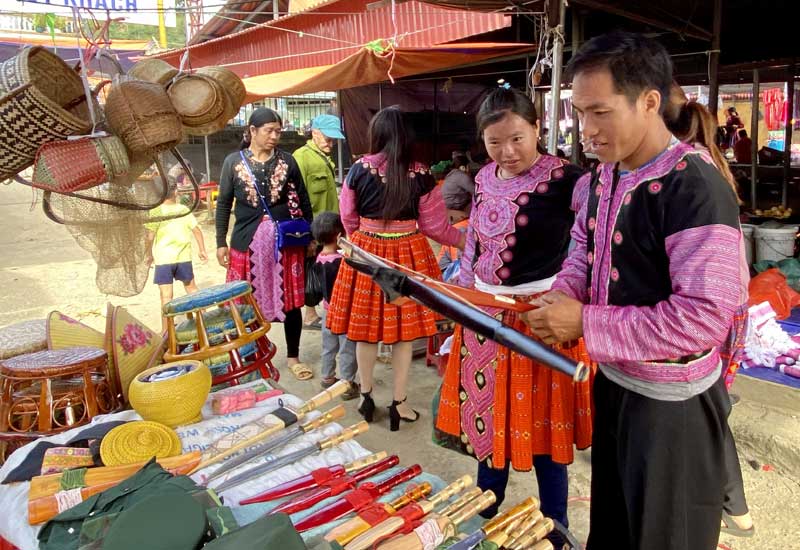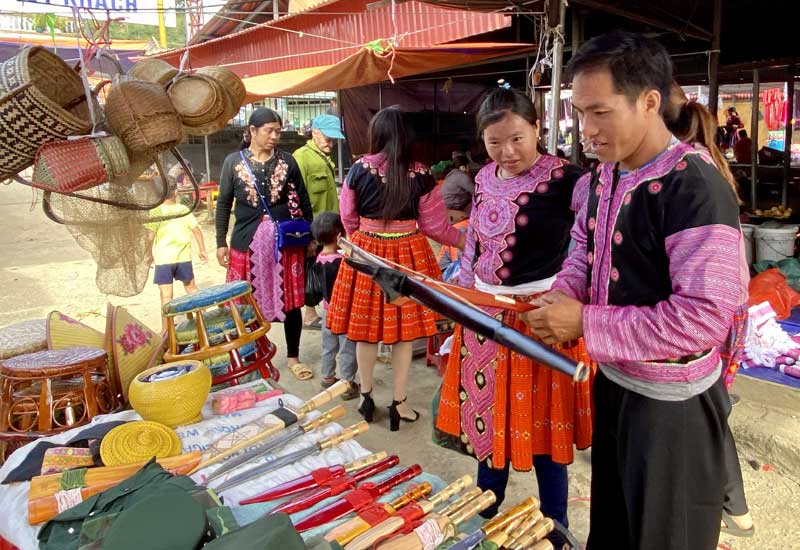
(HBO) – Traditional costumes are among typical cultural identities of ethnic groups. Now in Hang Kia and Pa Co communes (Mai Chau district), local Mong ethnic people still wear them almost every day, which impresses visitors and adds to the area’s attractiveness.

Mong ethnic people in traditional costumes of Hang Kia and Pa
Co communes visit a market.
Phang Y Mai, an elderly resident in Pa Hang
village of Pa Co commune, said Mong women have made clothes for their families
from generation to generation.
Men’s clothes are mostly black and have very
loose trouser legs so that men can easily climb hills and mountains to work or
practice traditional dances. Belts, called "lang dua la” in Mong language, form
an indispensable part of their clothes.
Meanwhile, women’s clothes consist of skirts and
blouses. Skirts, known as "ta” in the Mong language, are loose and pleated and
look like blooming flowers when spread out. They are also decorated with unique
patterns embroidered or printed carefully. Meanwhile, blouses, called "so”,
have V-shaped collars and are attached with pieces of cloth with wearers’
favourite colours. They also feature elegant decoration patterns and silver
coins creating joyful sounds when wearers move. Particularly, sleeves are
embroidered with colourful patterns, making the blouses more eye-catching.
Farming flax, weaving cloth, making clothes,
embroidering, drawing in beeswax, and dying patterns have become a traditional
craft of Mong women. Each costume of the ethnic minority is a result of its
maker’s month-long industriousness.
Nowadays, Mong people in the two communes are
still preserving traditional costumes in association with developing tourism as
a way to uphold their cultural identity. Besides, a traditional brocade making
village in Pa Co commune was also recognised in 2019.
Via efforts to preserve traditional costumes and
crafts, Hang Kia and Pa Co have been striving to introduce the local cultural
quintessence to visitors, thereby helping to develop local tourism./.
With an increasingly vibrant and widespread emulation movement aimed at building cultured residential areas and cultured families, Yen Thuy District has been making steady progress toward improving both the material and spiritual well-being of its people, while fostering a civilized, prosperous, beautiful, and progressive community.
Once lacking recreational spaces and community facilities, Residential Group 2 in Quynh Lam Ward (Hoa Binh City) has recently received attention for the construction of a new, spacious, and fully equipped cultural house. The project followed the model of state support combined with public contributions in both labor and funding.
The "All people unite to build cultural life" movement, which has been effectively integrated with Kim Boi district’s socio-economic development goals, is fostering a lively spirit of emulation across local residential areas, hamlets, villages, public agencies, and enterprises. In addition, through the initiative, traditional cultural values are being preserved and promoted, while community solidarity and mutual support in poverty reduction and economic development are being strengthened.
A working delegation of the Hoa Binh provincial People’s Committee led by its Permanent Vice Chairman Nguyen Van Toan on June 11 inspected the progress of a project to build the Mo Muong Cultural Heritage Conservation Space linked to tourism services in Hop Phong commune, Cao Phong district.
Born and growing in the heroic land of Muong Dong, Dinh Thi Kieu Dung, a resident in Bo town of Kim Boi district, in her childhood was nurtured by the sweet lullabies of her grandmother and mother. These melodies deeply imprinted on her soul, becoming an inseparable part of her love for her ethnic group's culture. For over 20 years, this love for her hometown has driven Dung to research, collect, and pass down the cultural values of the Muong people to future generations.
In the final days of May, the Ethnic Art Troupe of Hoa Binh Province organized performances to serve the people in remote, mountainous, and particularly disadvantaged areas within the province. These were not just ordinary artistic shows, but they were the meaningful journeys aimed at spreading cultural values, enhancing the spiritual life of the people and contributing to the preservation of ethnic minority cultural identities.



